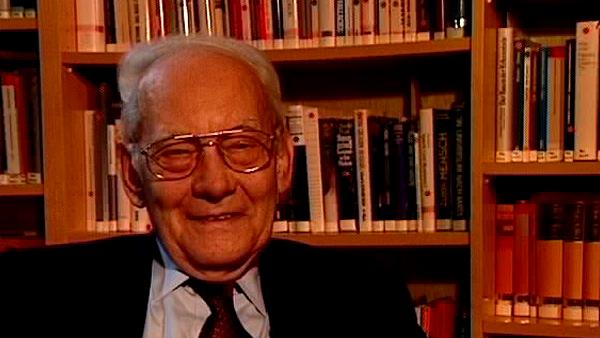NEXT STORY

Using viruses as models for evolution
RELATED STORIES

NEXT STORY

Using viruses as models for evolution
RELATED STORIES


|
Views | Duration | |
|---|---|---|---|
| 81. Rudolf Rigler: looking at fluctuations | 182 | 02:32 | |
| 82. Rigler's method of determining the rotation of single molecules | 84 | 02:46 | |
| 83. Reasons to focus into a small volume element | 89 | 01:46 | |
| 84. Using fluorescence correlation spectroscopy to observe a single... | 453 | 03:25 | |
| 85. Using primers to see single particles | 70 | 04:26 | |
| 86. Using nanotechnology to do evolutionary experiments | 57 | 04:20 | |
| 87. Viruses | 63 | 03:39 | |
| 88. Using viruses as models for evolution | 42 | 02:57 | |
| 89. The evolution of HIV | 48 | 03:28 | |
| 90. Anti-viral strategies | 38 | 04:49 |


Viruses are not autonomous living beings. Viruses are, so to speak, molecule complexes. Are they alive? Well, outside a host they cannot live autonomously. In other words they need a host, they have to infect a cell and then use metabolism of the cell and so on and the machinery of the cell. So if the virus are outside of the cell you can crystallise them... they are just like inorganic material. But once the virus penetrates a cell it has all properties of a living being, be it already... Name some of these properties, it is able to reproduce itself, it will undergo mutation so it can adapt to a new environment, by having these properties it has the property of selection, Darwinian type of selection. Well, what about metabolism? Well, it utilises metabolism of the cell, it utilises the building blocks of... the cell also has to synthesise nucleic acids and proteins, so it utilises that. And sometimes it so efficiently reprograms the cell that the cell dies and the virus multiplies in large amount.
Now you might ask, where do viruses come from? Isn't it a principle against life which they are based on, if they destroy their host they destroy their basis of life also. That evolutionary adaptation is usually done the other way around, that you provide the basis for your existence and not destroy the basis of your existence. But viruses might not have learnt that and perhaps are able to learn because we have seen already they have a very high mutation rate. They have the mutation rate which is simply the error rate of the polymerising enzyme which is of the order of one in ten thousand. So they make every... about every ten thousand replications they make one error, and if a virus contains ten thousand building blocks, well they make one per replication step. And that's how they build up a quasispecies of many different mutants.
Now we have studied very precisely the processes connected with it. Christof Biebricher using our [pet], the Q-beta, virus... phage Q-beta, has studied in detail the kinetics of these replication mechanisms and mutation processes and so on, and much of our knowledge is based on this. We also, and you yourself, were involved in this work. We also studied evolution of viruses. Now viruses most certainly are not prebiotic events, they are post-biotic events, because they need a host cell. So they can only come about when there is a cell, perhaps they were a part of the cell which got independent and used evolutionary tricks to become independent.
Nobel Prize winning German biophysical chemist, Manfred Eigen (1927-2019), was best known for his work on fast chemical reactions and his development of ways to accurately measure these reactions down to the nearest billionth of a second. He published over 100 papers with topics ranging from hydrogen bridges of nucleic acids to the storage of information in the central nervous system.
Title: Viruses
Listeners: Ruthild Winkler-Oswatitch
Ruthild Winkler-Oswatitsch is the eldest daughter of the Austrian physicist Klaus Osatitsch, an internationally renowned expert in gas dynamics, and his wife Hedwig Oswatitsch-Klabinus. She was born in the German university town of Göttingen where her father worked at the Kaiser Wilhelm Institute of Aerodynamics under Ludwig Prandtl. After World War II she was educated in Stockholm, Sweden, where her father was then a research scientist and lecturer at the Royal Institute of Technology.
In 1961 Ruthild Winkler-Oswatitsch enrolled in Chemistry at the Technical University of Vienna where she received her PhD in 1969 with a dissertation on "Fast complex reactions of alkali ions with biological membrane carriers". The experimental work for her thesis was carried out at the Max Planck Institute for Physical Chemistry in Göttingen under Manfred Eigen.
From 1971 to the present Ruthild Winkler-Oswatitsch has been working as a research scientist at the Max Planck Institute in Göttingen in the Department of Chemical Kinetics which is headed by Manfred Eigen. Her interest was first focused on an application of relaxation techniques to the study of fast biological reactions. Thereafter, she engaged in theoretical studies on molecular evolution and developed game models for representing the underlying chemical proceses. Together with Manfred Eigen she wrote the widely noted book, "Laws of the Game" (Alfred A. Knopf Inc. 1981 and Princeton University Press, 1993). Her more recent studies were concerned with comparative sequence analysis of nucleic acids in order to find out the age of the genetic code and the time course of the early evolution of life. For the last decade she has been successfully establishing industrial applications in the field of evolutionary biotechnology.
Tags: viruses, quasispecies, Q-beta, Christof Kurt Biebricher, Ruthild Winkler-Oswatitch
Duration: 3 minutes, 40 seconds
Date story recorded: July 1997
Date story went live: 29 September 2010